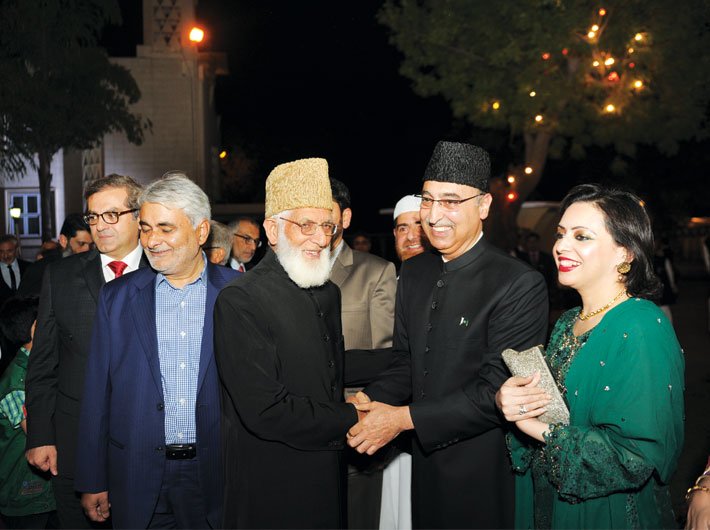Twice they have come in the way of official Indo-Pak talks, but on ground zero they are insignificant
The 1987 assembly elections had dashed hopes of many Kashmiri leaders, who were traditionally not reconciled to Kashmir’s accession, to board the mainstream political bandwagon. Tired of being on the edges of the political arena, a motley group of these leaders had cobbled the Muslim United Front (MUF) and plunged into elections, which, sadly for them, ended on a very bitter note. The elections were perceived to be hugely rigged and brazenly manipulated against them by the Farooq Abdullah regime.
Bitter and fatigued, most of the MUF leaders had almost retired to a quiet life. One of them, Abdul Ghani Bhat, popularly called ‘Professor’, would, at times, have visitors in his wooden house located in an apple orchard in Baitengu village in north Kashmir. He knew that the anger over fraud in the elections was alive. However, he had no idea as to how effectively this had been used by Pakistan to call an army of Kashmiri youth for arms training to its soil and send them back for an anti-India surge in the valley. Two years later, Bhat was ‘advised’ to get together with other MUF-wallas and give a political face to the Kashmir’s revolt.
It was in the autumn of 1993 that the All Parties Hurriyat Conference (APHC) or the ‘Hurriyat’ (which means freedom) in short was born and leaders like Bhat were back in job. Now there was a virtual race among the employee associations, trade unions, bar associations, chambers of industries and professional bodies to join the seemingly influential umbrella group of Kashmiri separatists. Bhat and others were back to the centre-stage holding rallies and leading marches. Their job rendered smooth in the absence of mainstream leaders, who had fled Kashmir due to targeted killings.
However, as it was meant to be, the apron strings of Hurriyat always remained with Islamabad. Even after 22 years, the umbilical cord of the Hurriyat with Islamabad remains intact. Interestingly, the Hurriyat leaders may not be popular in Kashmir but they are effectively used by Pakistan to browbeat India as was seen recently. Round the year they live in their dungeons but come alive when Pakistan wants to use them as was seen recently in the run-up to Indo-Pak engagements.
So, are the Hurriyat leaders Pakistan’s puppets? Do they have the capacity to bring peace in Kashmir?
Publically, most of the Hurriyat leaders tow Pakistan’s line on Kashmir. Others who have dared to question Pakistan on its real intentions on Kashmir had to face death or oblivion. Two leaders – Abdul Gani Lone and Sardar Abdul Qayoom – are the cases in point. Lone, a veteran Kashmir leader, was the first to raise the issue of Pakistan sending foreign mercenaries to Kashmir. Lone was killed in broad daylight.
Qayoom, premier of Pakistan-occupied Kashmir, had raised similar questions. He was no ordinary leader as back home he was called ‘mujahideen-e-awwal’ (the first revolutionary fighter). When he pointed to Pakistan misusing Kashmiri youth and throwing Kashmiri people in an abyss of violence, he too was shunted into political oblivion by the ISI and the Pakistan army. Despite winning the elections Qayoom was sidelined. Knowing the ISI too well, he accepted oblivion and allowed his son to rule as per the diktats of Islamabad. This ensured that nobody crossed the line drawn by the ISI.
Though the optics of it looked otherwise, the Hurriyat leaders had got on Atal Bihari Vajpayee’s peace bandwagon only after getting a nod from Islamabad. Sources say the back channel work had ensured that the Hurriyat got talking to the government of India, though the talks never took off. Islamabad wanted to fathom New Delhi’s vision and perception on Kashmir through this.
The Indian government had been blowing hot and cold on allowing the Islamabad-Hurriyat nexus grow. The first time Islamabad had put pressure on New Delhi on account of the Hurriyat was during the maverick General Pervez Musharraf’s visit to India. Much to the dislike of the Vajpayee government, he had insisted on meeting the Hurriyat leaders before he would meet the Indian premier in Agra. Delhi had to allow it for a bigger cause – striking peace with Pakistan. The meetings became a norm and gradually got ignored till the advent of the Narendra Modi government. Twice the Hurriyat has come in the way of India and Pakistan talking peace – once the secretary-level talks and then the NSA-level talks had to be cancelled due to them.
The Hurriyat leaders may have hogged all the limelight on TV channels in the run-up to the cancelled Indo-Pak NSA-level talks, but on ground zero they no longer enjoy popularity. The APHC has split many a time. In fact, a visit to its office in Rajbagh would make one understand why people in Kashmir no longer give them any importance. Currently, there are three factions of the Hurriyat each having a part of the building to itself. The leaders have no love lost for each other; in fact, some of them are not even on talking terms. Beyond photo ops, the Hurriyat unity lies shattered.
However, Hurriyat supporters say that without these leaders, the Kashmir insurgency would remain nobody’s baby and controlling it would be virtually impossible sometime. However, elected leaders have always resented the government allowing a free run to the Hurriyat leaders. National Conference leader Farooq Abdullah in fact congratulated the Modi government for taking a stand against allowing the Hurriyat-Pakistan meeting. But given their poor reputation and public image, whether the Hurriyat leaders would be of use as peacemakers at the right time is highly doubtful.
jayakhosa@gmail.com
(The article appears in the September 1-15, 2015 issue)
